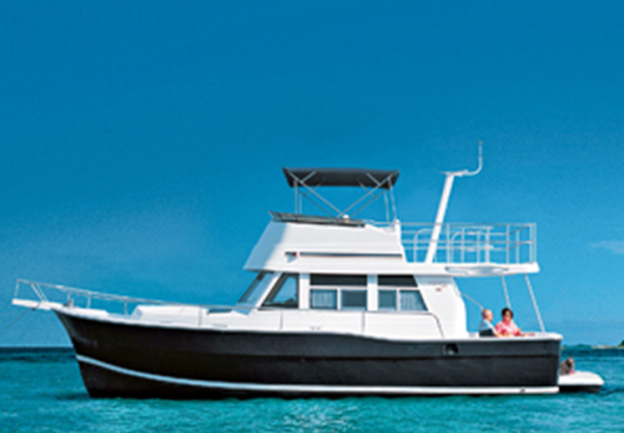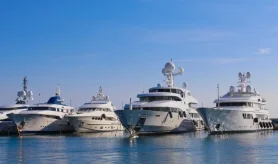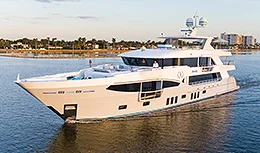- Alaskan Yachts
- Azimut Yachts
- Back Cove Yachts
- Beneteau Yachts
- Benetti Superyachts
- Bertram Yachts
- Boston Whaler
- Broward Yachts
- Buddy Davis Sportfish
- Burger Yachts
- Cabo Yachts
- Catamarans
- Carver Motoryachts
- Center Console
- Chris-Craft Yachts
- Cruisers Yachts
- DeFever Trawlers
- Dufour Sailboats
- Fairline Yachts
- Feadship Yachts
- Ferretti Yachts
- Filippetti Yachts
- Formula Yachts
- Fountaine Pajot Cats
- Grady-White
- Grand Banks Trawlers
- Hargrave Yachts
- Hatteras Yachts
- Hinckley Picnic Boats
- Horizon Yachts
- Hydra-Sports
- Intrepid Boats
- Jarrett Bay Sportfish
- Jeanneau Yachts
- Kadey-Krogen Trawlers
- Lazzara Yachts
- Lekker Boats
- Luhrs Sportfish
- Marlow Yachts
- Maritimo Yachts
- Marquis Yachts
- Mazu Yachts
- McKinna Motoryachts
- Meridian Yachts
- Midnight Express
- MJM Yachts
- Mochi Craft
- Neptunus Motoryachts
- Nordhavn Trawlers
- Nordic Tugs
- Numarine Yachts
- Ocean Alexander Yachts
- Ocean King
- Offshore Yachts
- Outer Reef
- Oyster Sailing Yachts
- Pacific Mariner Yachts
- Palmer Johnson Yachts
350/390 Mainship
![]()

Source: Pierce Hoover, Power & Motoryacht Magazine
The 350/390 was in many ways a benchmark design for Mainship. It was also the most successful trawler in the company’s history and remains a popular model on the used boat market.
First introduced as the 350 in 1997, the boat sold well. After a product run of nearly 100 units over a two-year period, it received some minor interior changes and hardware upgrades and was rechristened the 390. By the end of its production run in 2003, some 501 350/390 hulls came off the line at the St. Augustine, Florida, facility. Most are still in service in locations across North America and beyond.
From its inception, the 350/390 was considered a handsome boat, blending traditional lines with a modern exterior finish showing minimal brightwork. A full bridge deck overhang protected the walk-around side decks a feature which endeared the boat to many couples, as it facilitated two-person linehandling and movement through locks.
Another styling element introduced on the 350/390 which has since become a signature of the entire Mainship Trawler line was the molded stairway leading from the cockpit to the flying bridge. Numerous owners commented on the convenience and safety of this feature, which also allows on-board pets to reach the upper deck. The bridge deck itself was one of the boat’s other major selling points. Much more than just an elevated helm, the expansive flying bridge included seating for eight to 10 guests, a generous folding table, the option of a grill station and wet bar and ample room for tender storage.
Large windows give the salon an open feel, and though space is always at a premium on a boat of this size, the 350/390 manages to provide realistic living spaces for a couple, plus the occasional guests or a pair of children. The galley is located up and forward on the port side, providing the cook with a view of passing scenery and creating the necessary room below for the second stateroom. With a compact hanging locker and standing headroom at its forward section, the space is adequate but not generously proportioned.
Other living spaces, such as the master stateroom and head which includes a separate stall shower make good use of available space. Based on personal experience, I know a 6-foot-plus male can move about the interior with ease. The few areas that require a slight duck under or side slide are quickly learned and soon become a nonissue.
Instead of a traditional full displacement trawler hull, Mainship chose a semi-displacement design that maintains a wide stern profile. Depending on power, this allowed the 350/390 to operate efficiently in the 7- to 8-knot range while delivering fuel-efficiencies in the 2 to 3 nmpg range, combined with the ability to reach speeds of 14 knots in single-engine boats or as high as 18 knots in twin-engine models. The factory offered the boat with a variety of engine options, including single and twin Yanmars and Volvos, and single Cat or Cummins options.
The standard genset was an 8 kW Kohler, which fit snug under the cockpit and provided what many owners reported to be more than enough power. Earlier units were not set in sound shields and were powered by a 3,600 rpm engine. Later models ran quieter and were enclosed in soft or hard shielding.
Though never intended as a bluewater passage maker, the 350/390 is by no means consigned to life inside the jetties. Thanks to its ample bow flair, the boat does yeoman duty in head seas. The combination of an elongated keel, full aft section and smallish rudder will keep the helmsman busy in following seas, as the hull does tend to wander. Motion in a cross-sea is what one would expect, considering the boat’s generous topside profile. In a beam sea of 3 feet or more, passengers may begin to gravitate to the lower deck, not for reasons of safety, but merely comfort.
Slow-speed maneuvering was not one of the boat’s strong suits, but docking was made considerably easier thanks to the standard bow thruster. Early models were fitted with a less-effective 4 hp thruster, which was later changed to a 7 hp model. Some 350/390 owners retrofitted their boats with articulated rudders, which is said to enhance low-speed handling.
The overall build quality of the 350/390 was good, especially when considered in the context of price, as this boat sold for much less than $200,000 when new. Owners have reported some specific issues with individual hardware items, and occasional reports of osmotic blistering circulate on the Internet. In reality, however, this is not a significant concern, as factory records show a reported incident rate of less than 1 percent for blister damage.
Today, the 390 remains a prime choice for two major market segments: families looking for a roomy, cost-effective boat for weekend and vacation getaways and couples looking to do extended cruises. Quite a few of these boats have completed the Great Loop, wintered in the Bahamas and explored the Inside Passage. They can be found in charter fleets from the North Channel to the Virgin Islands, and at any given time, there are usually a half-dozen or more on the market at prices ranging from a bit less than $100,000 for a fixerupper to as much as $200,000 for a meticulously maintained model.
Boat Specifications: 350/390 Mainship
LOA: 39’9”
BEAM: 14’2”
DRAFT: 3’8”
DISPLACEMENT: 22,000 lbs
WATER: 130 gals
FUEL: 300 gals
POWER: Single or twin diesel to 480 hp



